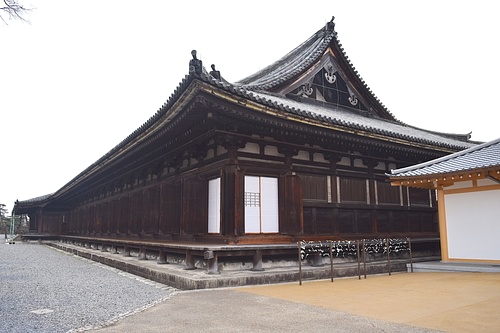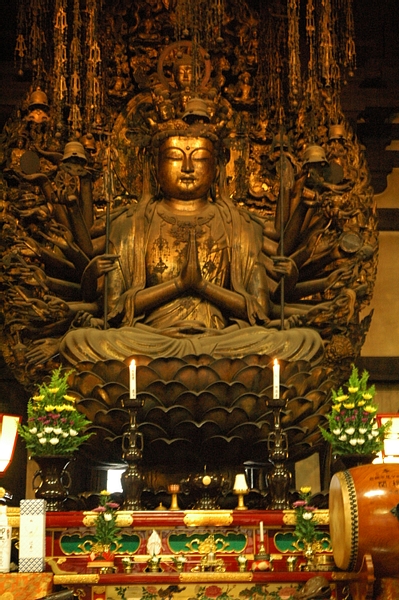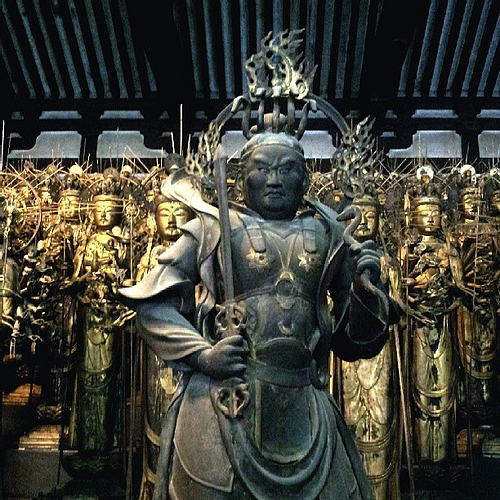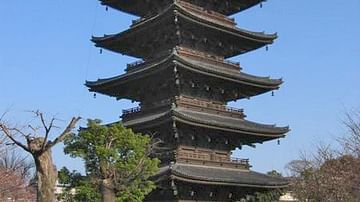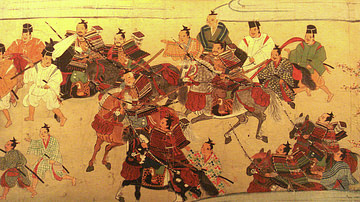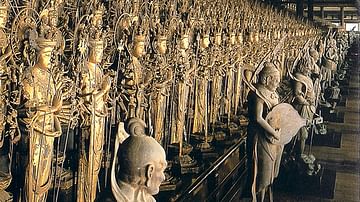
Sanjusangendo is a Buddhist temple which is part of the Rengeo-in monastery in Kyoto, Japan. Founded in 1164 CE, the temple is famous for its impressive dimensions and the 1,001 golden Buddha figures and 28 guardian statues which stand inside it. The temple is listed as a National Treasure of Japan.
The Temple Hall
The Sanjusangendo temple's official name is Rengeo-in which means 'Temple of the Lotus King Kannon-bosatsu' and is dedicated to Kannon (full name: Juichimen-Senjusengen-Kanzeon), the bodhisattva better known as Guanyin. The temple was founded in 1164 CE by the retired Emperor Go-Shirakawa (r. 1155-1158 CE) in Kyoto or Heiankyo as the then capital was known. Some sources credit the foundation to the court official Taira-no-Kiyomori (1118-1181 CE), a member of the powerful Taira clan. It was originally located in the centre of the Ho-juji Palace, the residence of Go-Shirakwa which was destroyed in 1183 CE with only the Sanjusangendo surviving.
The huge temple building has only one storey but is 120 metres (393 ft) long and 16.5 metres (54 ft) wide. The colloquial name of the building means 'a hall with 33 spaces between columns' and describes the facade of the building. 33 is also a number sacred to Kannon as the bodhisattva was thought to have had 33 manifestations and the most important pilgrimage route in his honour stops at 33 temples. There is a single entrance on all four sides, a veranda around the building, and the roof is tiled and gently sloping outwards and upwards at the corners.
The temple building is so large that it has long been used in archery contests beginning in the 16th century CE. The winner of such competitions had to fire the most arrows the entire length of the temple. To illustrate the difficulty of the task, in a contest in 1686 CE the winner, one Wasa Daihachiro, managed to fire only 8,133 of his 13,053 arrows the required distance. The tradition continues today in the annual Toh-shiya ('piercing arrow') competition held each February.
The hall is in the native Japanese style (Wayo) as opposed to the more common temple architecture influenced by China. The exterior walls are painted red with the window frames in blue. Inside, the roof beams and rafters are left exposed, a typical feature of the Keshou-yaneura architectural style which dates back to the Nara Period (710-794 CE). The original temple was destroyed by a fire in 1249 CE but rebuilt exactly at the behest of the retired Emperor Go-Saga (r. 1242-1246 CE). Completed in 1266 CE, it has been renovated four times since then.
The Sanjusangendo temple is surrounded by an earth wall with a roof and accessed via two gateways. Both the wall and the South Gate date to 1590 CE when the regent Toyotomi Hideyoshi (1537-1598 CE) improved the site; both structures are in the Momoyama style and are listed as Important Cultural Properties of Japan.
Interior Sculptures
Inside the Sanjusangendo are many fine figure sculptures with the most important being the statue of the Thousand-armed Kannon. The giant seated golden figure of Kannon is a National Treasure of Japan and represents the familiar vision of the all-seeing, all-encompassing bodhisattva with eleven faces (one normal head and then one each for the eight directions plus one for heaven and one for earth) and 1,000 arms (a number representing infinity in Sanskrit). This figure has the eleven faces represented as a crown of heads and 20 pairs of arms. On his halo, there are 31 miniature representations of the Buddha. Each hand holds an object of sacred significance such as a sutra scroll to represent learning, a willow tree for healing, a sword for banishing devils, and an axe to fight against misfortune. Kannon sits on an octagonal lotus flower with seven levels of petals. The figure is 3.3 metres (11 ft) in height. Ink inscriptions inside the body of the figure and on the lotus seat indicate it is the work of the great Kamakura Period (1185-1333 CE) sculptor Tankei, who was the leader of the Kei-ha school of Buddhist sculpture and who would have been 82 at its time of creation in 1254 CE.
Either side of the seated Kannon figure filling half the temple are 1,000 smaller statues of Kannon, each being around 1.7 metres (5.5 ft) in height. Made by a team of sculptors over a period of 15 years, they are near-identical with only very minor differences in facial expression and folds of the robe. Set in ten parallel tiers, they all face the same direction, east, and each has 20 arms and a halo with rays. All of the gilded figures are designated as Important Cultural Properties of Japan. 124 of them date to the original founding of the temple in the 12th century CE, while the other 876 were made a century later in imitation of the lost originals. Around 500 of the figures are signed by the sculptor on the base and include works by such famous names as Ryuen, Inga, Tankei (who made nine), and Koen, Tankei's great pupil and successor.
The main Kannon statue and the 1,000 smaller figures are all protected by 28 attendants and guardians, all placed on a raised platform and set in a single row in front. Standing around 1.6 metres (64 inches) tall, many derive from Indian Buddhism and mythology. A lively group of action figures, they each represent such concepts as beauty, wisdom, prosperity, charity, justice and strength. At either end of the hall, with each standing on a raised platform in the shape of a cloud, are two more figures, this time of Raijin, the god of thunder, and Fujin, the wind god. The statues are around one metre tall (40 inches) with the wind god represented holding a bulging sack full of wind while the thunder god is surrounded by a circle of eight small drums. Both figures date to the Kamakura Period.
All of the statues in the Sanjusangendo are made from cypress wood and by the same technique known as yosegi-zukuri, that is, with individual parts sculpted separately, joined and then coated with lacquer. Finally, the figures were either painted or gilded with gold leaf and the eyes set with quartz.
This content was made possible with generous support from the Great Britain Sasakawa Foundation.
